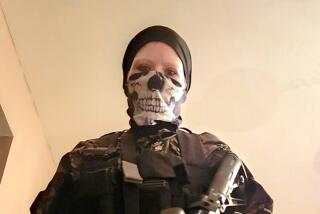Factoring Equations Into the War on Terror
- Share via
PISCATAWAY, N.J. — Terrorism takes brains.
You don’t need political influence, military might or economic resources to plant bombs or take hostages; but without brains, terrorism is nothing more than random violence.
Consider Al Qaeda’s attack on New York City and Washington, D.C., three years ago. It required only 19 men armed with box cutters, yet it was so brilliantly conceived, meticulously planned and keenly attuned to global politics that it changed the world.
“Terrorism is a thinking man’s game,” terror expert Gordon Woo said.
Which is why a small group of thinking men and women convened at Rutgers University last month to consider how order theory -- a branch of abstract mathematics that deals with hierarchical relationships -- could be applied to the war on terror.
It almost seems ridiculous for people who inhabit a world of concept lattices and partially ordered sets to think that they can affect a war that is being fought on the streets of Baghdad and in the remote mountains of northern Pakistan. But the war on terror is also fought in cyberspace and in the minds of people from Lahore to Los Angeles. Mathematicians are right at home in such abstract realms.
“It’s not just theoretical,” said Fred Roberts, director of the Center for Discrete Mathematics and Theoretical Computer Science, the Rutgers research institute where the conference was held.
Mathematician Jonathan Farley of the Massachusetts Institute of Technology said he was inspired to organize the meeting by the movie “A Beautiful Mind.” The film tells the story of mathematician John Forbes Nash, whose work in game theory found application in Cold War military strategy, international trade and the auctioning of broadcast frequencies by the Federal Communications Commission.
“I’m a pure mathematician, so I’m completely useless for the most part,” Farley said. “But it would be nice to take some of what we do and make it useful for some people -- maybe even life-saving.”
The new Homeland Security Institute has a mandate from Congress to do just that, Gary G. Nelson said. A senior researcher at the quasi-governmental institute, he attended the conference in hopes of finding research projects for the institute to support.
Some ideas sounded promising, Nelson said. The most intriguing were those that could help intelligence agencies boil down the vast amounts of data they contend with.
Other proposals were “a pretty long logical distance” from the real world. And not everything was easy to understand, he said, even for a systems engineer.
Theoretically, Farley said, abstract math could help intelligence officers figure out the most efficient way to disable a terrorist network.
Say it’s cheaper or more practical to go after a terrorist cell’s “middle management” rather than its leadership. How many of those lieutenants would you have to remove to disrupt communication between the top dogs and field operatives? Are there one or two key individuals whose capture would completely cut off the chain of command?
Order theory is all about such questions.
“This helps them decide where to spend the money,” Farley said.
Of course, many times, the organizational structures of terrorist groups are unknown. Mathematical techniques could also be applied to that problem by using computer programs that comb through giant databases looking for connections between individuals, locations or events. For example, a program might discover that everybody involved in a given attack attended the same London mosque. Or it might find large numbers of e-mail messages between members of one terrorist cell in Germany and another in the United States, suggesting that they may be working together.
Such data-mining techniques are nothing new. But the explosion in computing power over the past few years has spurred innovation in the field.
Jafar Adibi, a computer scientist at USC, is developing ways to find hidden links between known terrorists and their as-yet-unknown confederates.
“You’re trying to detect major groups of these bad guys,” Adibi said.
The technique relies on having an initial group of known terrorists. Then it analyzes things those known terrorists have in common with other people in the database, such as phone calls, places of worship, political affiliations or blood relation.
The program concludes that anybody who has enough connections of the right kind with a known terrorist probably is one also.
Adibi has tested his program using a database built from newspaper accounts and other publicly available information. He labels 20% of a terrorist group’s members as “known” and challenges the program to find the rest. Right now, the system misses 20% of the remaining members, and three of the 10 people it does identify as “bad guys” aren’t actually terrorists.
Adibi said he hopes to improve those numbers a bit. But even so, programs like his could help focus anti-terror efforts on the most likely suspects.
Mass detentions by law enforcement authorities have often snared too many innocent people, Woo said.
Britain has arrested more than 600 people on suspicion of terrorism since the Sept. 11, 2001, attacks and convicted only 15 of them. By some counts, the United States has detained more than 5,000 foreign nationals under provisions of the Patriot Act, alienating them and their families.
“Part of the war on terrorism is winning hearts and minds,” said Woo, an analyst in the London office of Risk Management Solutions.
The Newark, Calif.-based consulting firm assesses catastrophe risks for the banking and insurance industries.
Minds are the specialty of Vladimir Lefebvre, a cognitive scientist at UC Irvine. The Russian-born researcher has spent his career developing ways of reducing human decision-making to mathematical equations. The work stems from a top-secret Soviet research project that Lefebvre worked on during the 1970s.
“I can compute feelings,” he said with a grin.
Lefebvre’s ideas are so obvious that you wonder if he might be kidding. Every person, he argues, has a view of the self that he or she uses as a tool for making decisions. That view can be influenced by the outside environment.
So, in principle, there ought to be things we can do to make terrorists feel less sure about themselves or less ardent in their beliefs. The right strategy might even make them think of themselves as something other than terrorists.
Lefebvre believes that human decision-making is so straightforward that simple equations can describe how an individual’s behavior arises from his or her self-image as it is shaped by other people and the environment.
Stefan Schmidt, a New Mexico State University researcher who has worked with Lefebvre, offered a hypothetical example: Suppose terrorists were considering three points of entry into the United States -- the Pacific Northwest, the Southwest and the Northeast. Looking at the level of security on the various borders and considering other factors such as remoteness, terrorists might decide on the Southwest as the best place to cross.
Assume that border agents, on the other hand, are heavily guarding the Northeast border. They would benefit by making the Southwest seem more heavily patrolled than it really is and the Northeast appear relatively unprotected. If they did a credible job, the terrorists would incorrectly choose the most secure border as their best bet and run a much higher chance of being caught.
Conceptually, this kind of reasoning is no different from military strategy. If you can plant an inaccurate idea in your opponent’s head, you will have an advantage on the battlefield.
But actually doing that -- at least for the time being -- requires a combination of brilliance, instinct and luck that few people possess. Lefebvre would reduce the process of outwitting your opponent to a computer program.
In some ways, researchers at Carnegie Mellon University have done just that. Computer scientist Kathleen M. Carley heads a lab that tries to simulate all kinds of social groups, including terrorist organizations.
The lab has built simulations of Hamas and Al Qaeda by dumping newspaper articles and other publicly available information about the organizations into a computer database. A program then takes that information and looks for patterns and relationships between individuals. It finds weak and strong figures, power brokers, hidden relationships and people with crucial skills.
Then another program can predict what would happen if a specific individual were removed from the organization. After Israel’s assassination of Hamas founder Sheik Ahmed Yassin in March, the program correctly predicted that he would be succeeded by hard-liner Abdulaziz Rantisi.
A month later, Israel assassinated Rantisi. Carley’s lab predicted that Hamas political director Khaled Meshaal would succeed him and posted its pick on the Internet.
This time, Hamas declined to reveal who had taken power for fear that he too would be assassinated. But eventually it became known that Meshaal was indeed the one.
At that point, Carley said, “we were told to quit putting such predictions on the Web” by federal officials.






